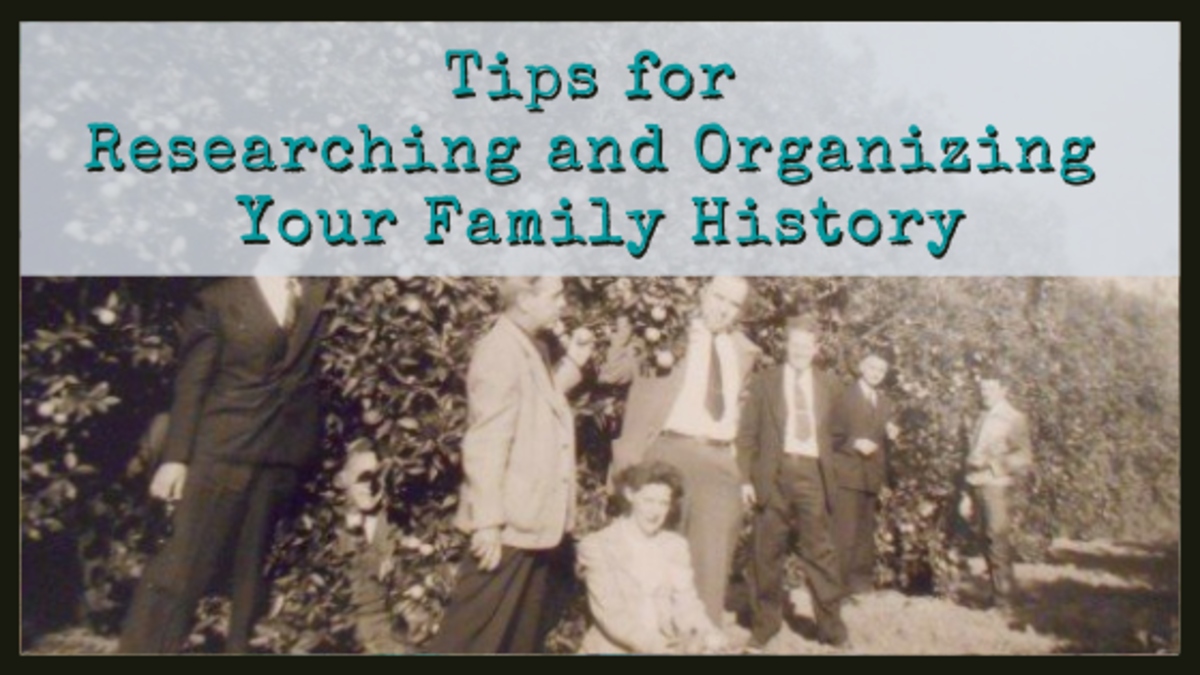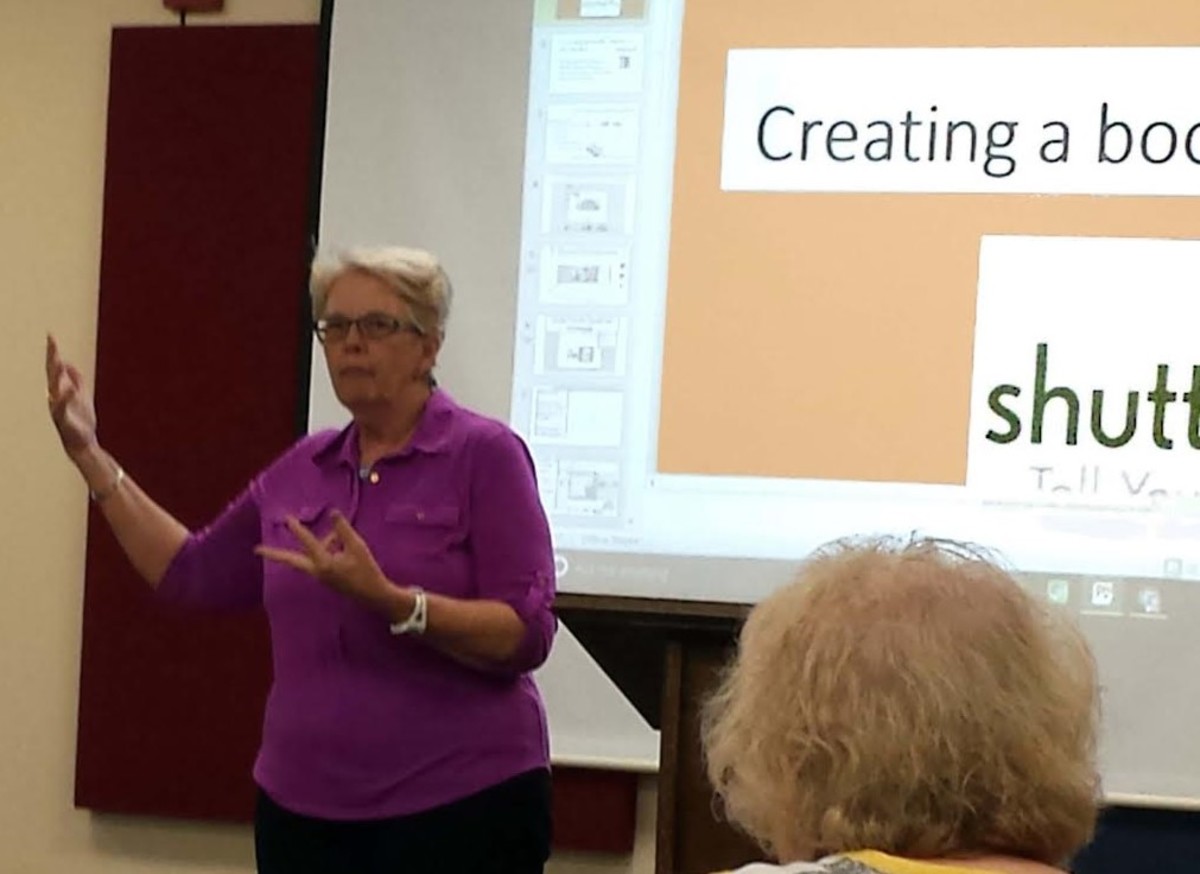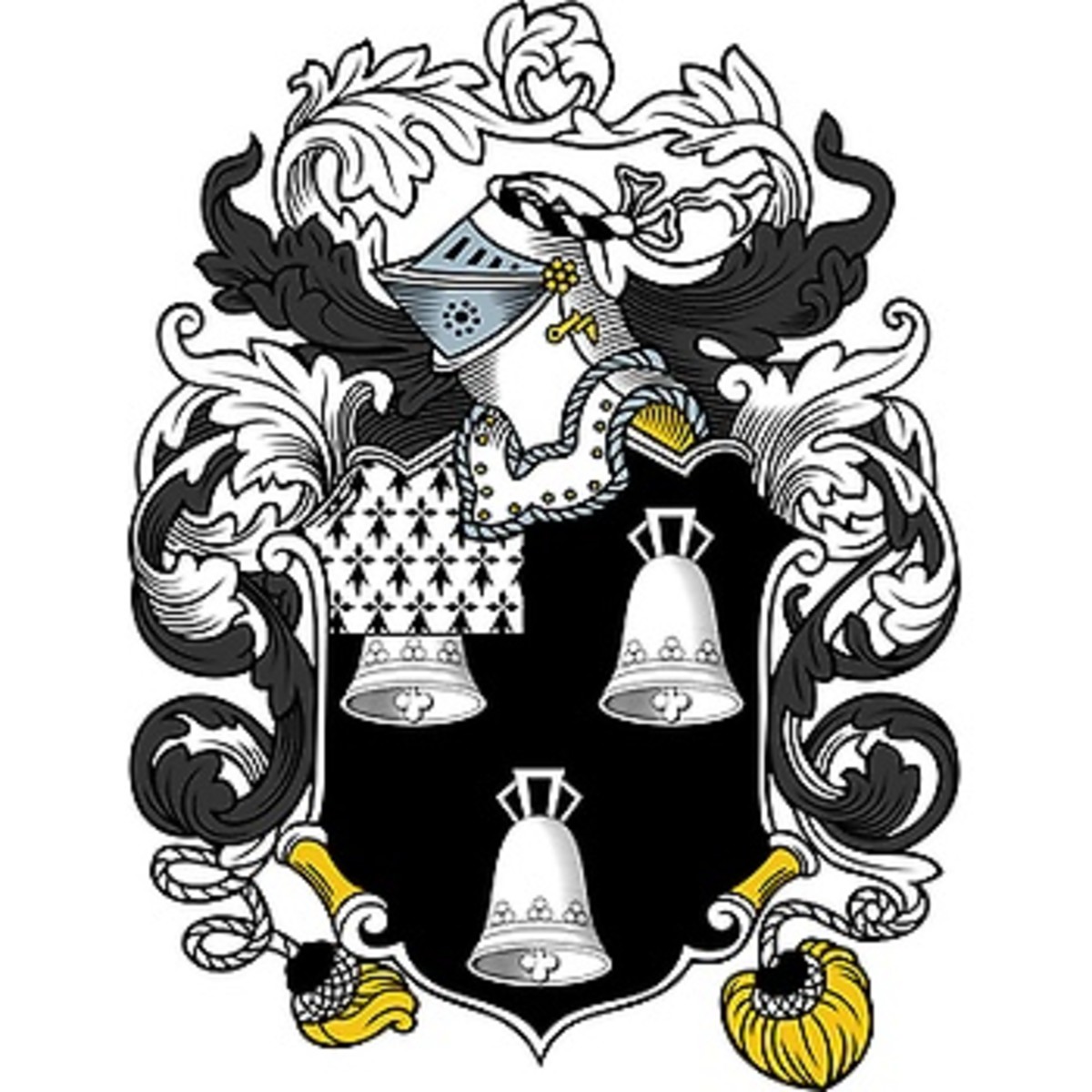Using Census Records Online
Using Census Records, Part 2
Using Census Records, Part II
Census records of the general population are the basic research tools for researchers who are looking for those that lived between 1850 and 1940, as it can easily be used both online and at libraries and can be copied and/or printed for personal use. Most of the population censuses have been indexed by volunteers and are available online at FamilySearch.org. With FamilySearch you can use the search engine and (most of the time) quickly find the families you are researching.
For starters, you need to know what “important questions for you” were asked each year so you can look for those answers. You will find as you go back in years less questions were asked and in some cases different questions were added or omitted as the government needed certain information.
Official Census Date
Each census has an “official census date” that base questions as “as of that date” and yes you will find children born after that date listed, so be sure to note the date the actual census page gives when you find your family. And it is very important that you make sure you document exactly where you found the information so you can go back again and again and pull more information as you need it. If it is my direct line, I print out a copy of the census page. With FamilySearch you can view the image and print a copy or download a copy of the image and attach it to your ancestor in the computer program, just like a photo!
LOOK at the image itself
I cannot stress enough how important it is for you to LOOK at the image itself. Not all the information given was transcribed onto the copyable FamilySearch listings. Again, if it is your direct line, LOOK at the image. I have been told by plenty of college professors if they say something three times it will be on the test. So…. LOOK AT THE IMAGE. Got it? I sure hope so.
Spelling does not count
And as a word of warning, spelling does not count. I have found at least 13 ways to spell Womack, including the phonic spelling of Wom – ick. Most strangers in this day and age pronounce and spell it as Wo –mack. And of course there is the spelling as Wommack or Wormack, Wormic, Wammac, and on and on.
Location of the Original Census Records
Individual census records from 1790 to 1940 – or those that have already been released to the public – are maintained by the National Archives and Records Administration and not the U. S. Census Bureau.
1950 to 2010 Census
Records from the 1950 to 2010 census can only be obtained by the person named in the record or their heir. (Just so you know, it takes a long, long – months even – time to get these records. And you need to know the exact location where they lived. Yes, I know from experience of ordering!) The 1950 census is scheduled to be released on April 1, 2022. So… mark your calendar.
General Question All Census Ask
Each census asked the basic questions of: name, and age, as well as some questions about education and occupation. The 1870 census had a column for parent’s place of birth. Starting with the 1880 census, each person gave their relationship to the head of the household. The 1900 census was the start of marital questions as well as asking the mother about the number of children she had and how many were still living. That year also saw the start of intense questioning about immigration and language spoken in the home, plus if the home was a farm or a house.
Those along with other personal questions are the important ones for you at the beginning of your research. There were many other questions asked during the census that as time progresses you may need to know the answers to such as the exact location of the family at the time of the census (town, street, house number) and who were their neighbors, actual date of the survey, and etc. (oh yes you will go back for those too!)
Released Census for Public Use
These census are available online and at libraries.
1940 Census
The 1940 census was released for public use in 2012. The official census date was April 1, 1940. Only a percentage of the population were given a longer census form with more questions. Some of those over age 14 were asked if they had a social security number and if they paid into the system in 1939. Some of the women were asked if they were married, how many times they had been married, and how old they were when they married the first time. And there was a column that questioned military service. There were also census for Indians (Native Americans) and a special housing census.
1930 Census
The 1930 census was released for public use in 2002. The official census date was April 1, 1930. For this census, questions included occupation and work history, and if they actually worked yesterday! Also they were questioned as to if they lived on a farm, value of home or rent, and if they owned a radio set. And special questions were for veterans and what war they served in. There was a special farm schedule taken but these no longer exist. There also was a special census for Indians (Native Americans)
1920 Census
The 1920 census was released for public use in 1992. The official census date was January 1, 1920. This census also questioned their citizenship, year of immigration into the US, as well as if they were naturalized. Other questions included occupation and work history, and if they actually worked on a farm!
1910 Census
The official census date was April 15, 1910. A special column asked “Whether a survivor of the Union or Confederate Army or Navy.” Still other columns asked if they were blind, deaf, or dumb.
My grandparents knew these people!
1900 Census
The official census date was June 1, 1900. In this census along with the basic questions, they were also asked how many years they were married, mother of how many children, and how many children still living. Citizenship questions included what year they immigrated and what year they were naturalized.
From this census page you can see how my family grew and prospered in Louisiana. I actually grew up hearing the stories of these people from my parents and grandparents who personally knew these people. I visited their homes which their children still lived in. I talked to the children and grandchildren of my ancestors, cousins, and other close relations.
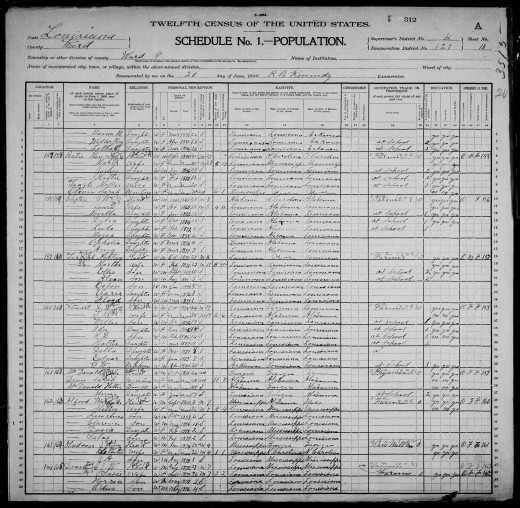
The Burned Census
1890 Census
Most of the 1890 census was burned in a fire, which is a shame as it had so many good questions we could glean information from as some of these people were probably born before 1850. However for those lucky enough to have ancestors in the unburned counties there is a wealth of information.
There are three rolls of census microfilmed. They include the census of Perry Count, Alabama (beat #11 and #8 and some other fragments); a few sections and fragments from the District of Columbia; and the same from the following census areas: Muscogee County, (Columbus) Georgia; McDorrough County, (Mound Twp) Illinois; Wright County, (Rockford) Minnesota; Hudson County, (Jersey City) New Jersey; Westchester County (Eastchester) and Suffolk county (Brookhaven Twp.) New York; Gaston County (South Point Twp and River Bend Twp) and Cleveland County (Twp #2) North Carolina; Hamilton County (Cincinnati) and Clinton County (Wayne Twp), Ohio; Union County (Jefferson Twp), South Dakota; Ellis County (J. P. #6, Mountain Peak, and Ovilla Precinct), Hood County (Precinct #5), Rusk County (#6 and J. P. #7), Trinity County (Trinity Town and Precinct #2) and Kaufman County (Kaufman), Texas.
The June 1890 census asked for “Christian name in full, initial of middle name, and surname; whether a soldier, sailor, or marine during civil war, union or confederate, or widow of such person; relationship to head of household and specific race. This is the only time I have seen race specified as to white, black, mulatto, quadroon, octoroon, Chinese, Japanese, or Indian.
Governmental type questions range from how many years they were in the United States and if they were naturalized or had applied, plus the census asked how many months they were unemployed during the census year.
Specific columns address afflictions and ask if they were “suffering from acute or chronic disease, length of time. Also if they were defected in mind, sight, hearing, speech, crippled, maimed, deformed and name of defect. Another column asked if the person was a prisoner, convict, homeless child, or pauper.
During this census, there was a separate veterans schedule prepared.
1880 Census
The 1880 census asked the basic questions of name, age at last birthday, sex, color, relationship to head of household were asked, along with columns to denote their marital status, if they married within the census year, place of birth of the person and their parents. As in the 1890 census, the government asked about health, occupation, school attendance and literacy.
As you can see from the 1880 Louisiana census, the Lacey family made the trip from Alabama okay, but by time they left Alabama, James Lacey himself had died (just before leaving on the trip according to family stories) and one small child was killed during the trip (by falling under a wagon) but just using this census page alone I can put together several families. The Dean/Deen, Lacey, and Clifton families all came together in the same wagon train. Draton Deen's wife was James Lacey's daughter! And G. D. Clifton’s wife was also a daughter of James Lacey’s. Actually Gilbert Cliffton married two Lacey children. After his first wife, Elizabeth, died, Gilbert married her sister, Mary. Gilbert had a total of twelve children.
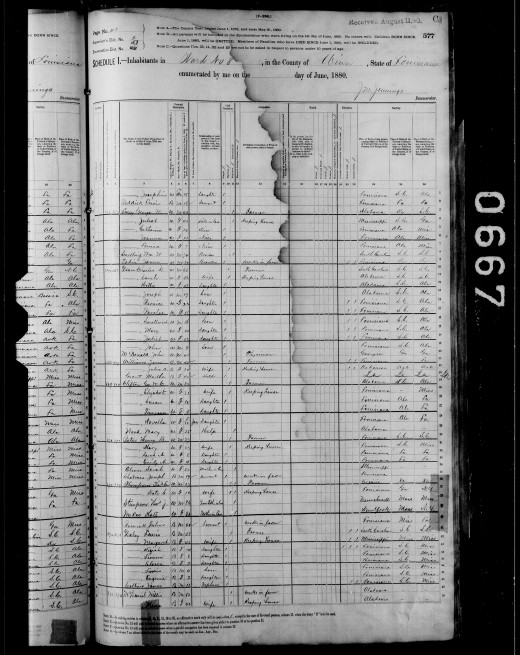
Tax Time Census and the Remarks Column
1870 Census
The 1870 census asked even less questions, with only the basic questions of name, age at last birthday, sex, and color, relationship to the head of the household, occupation and place of birth. It did ask if the father and mother were foreign born, month born in census year, month married if in census year, and the standard education questions of if they could read, write, or speak English. But they did not forget to ask the value of both real estate and personal property. Tax time!
1860 Census
As you can see the further back in time you go, the less information was asked during the census survey. Still the basic questions of name, age, sex, color/race, relationship, occupation, and place of birth were asked. As in the 1870, the 1860 asked about personal and real property, married within year, and if they could read and write. My special column was the one “Remarks.” Sometimes you got lucky and the census taker wrote something important there! A rare find when they did.
First Census to enumerate every person
1850 Census
The 1850 census was the first one to enumerate every person in the household. The basic questions of name, age, sex, color, occupation, and place of birth are listed. Married within year, read, write and the remarks column are also listed. The 1850 census does not give relationship to house.
The following 1850 Census record is of my James Lacey family in Alabama. Yes, it does look like Stacy and that is the way it was indexed, but since I know the family I can prove out each child, etc. Also it took me looking at many rolls of microfilm 30 years ago to find them. Fortunately this particular census was very clear and easy read.
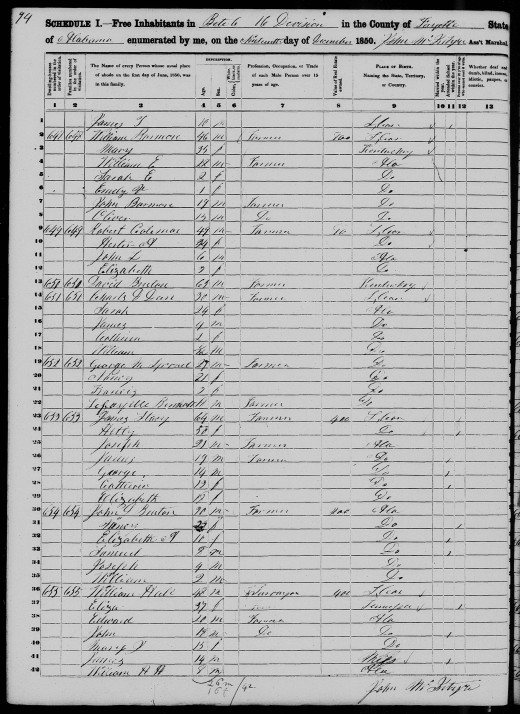
And in Conclusion
Conclusion
As you can see the census for the last hundred years can yield a lot of information. The earlier census from 1790 to 1840 also can yield information but you have to work for it. Just be sure to LOOK at the image itself.
Once you have exhausted the 1850 to 1940 census for your direct and easily recognized family, you will get down to working for the information. One way is to do cluster research. Another is to dive into reading the courthouse records. If you can’t find your families in the population census, try using one of the special census such as veterans or slave schedules. All of these and other ways of doing research will eventually be addressed by me. Researching and writing out how to research helps me organize my research process and since I already have it down on paper, why not share. Hope it helps you in your research.



